Menu
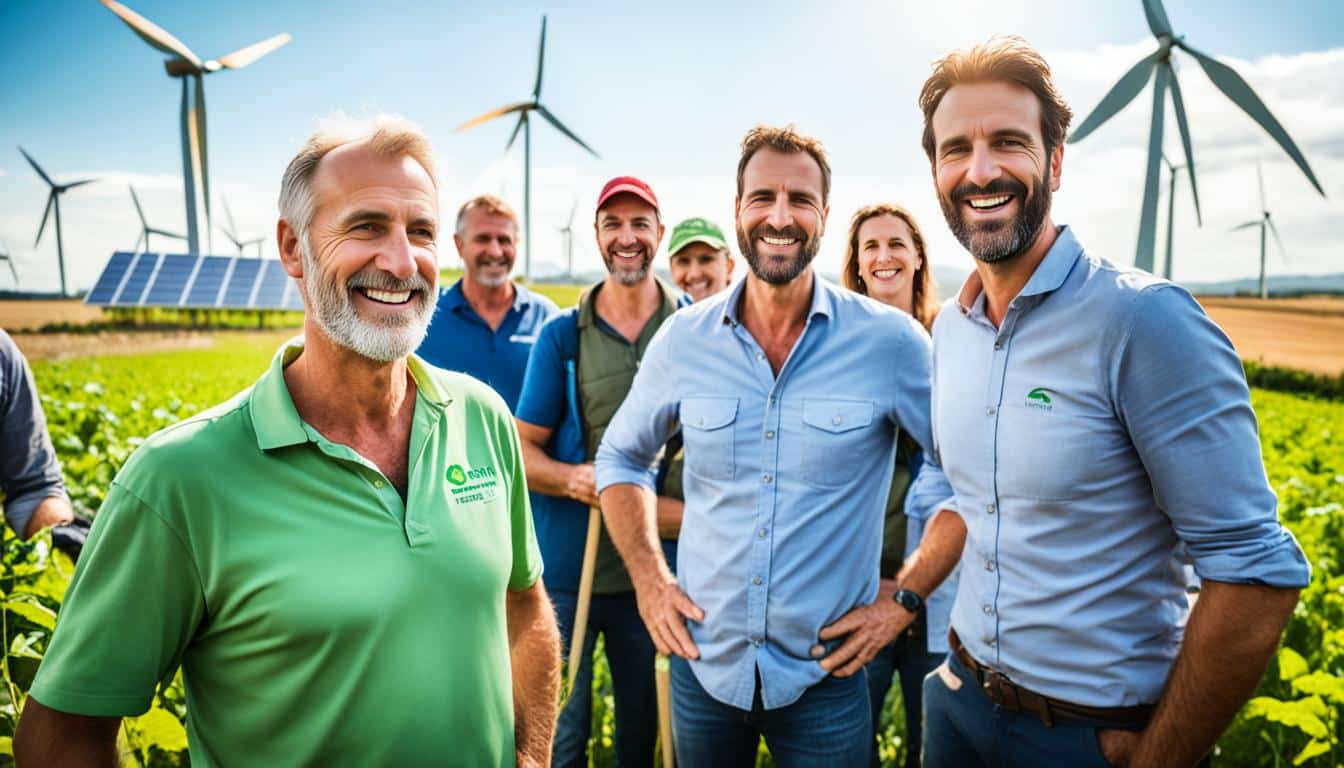
Did you know that 98% of Australia’s wheat comes from CGIAR‘s work? This shows how important global cooperation is for farming. Governments, businesses, and non-profits join forces in Public-Private Partnerships (PPPs). These partnerships help spread technology and open up new markets for farmers.
Small farmers benefit a lot from working together. They can get better prices, loans, and supplies. They also have more power when they sell their products. International help brings money, knowledge, and rules that support farming. This teamwork is key for keeping farming sustainable, increasing food safety, and helping rural areas in poor countries.
In a world more connected than ever, global alliances in farming are key. These partnerships boost food safety and help agriculture’s economy grow. By working together, countries can solve problems better, using a wide range of skills and resources.
Collaboration across borders is vital for making food safer. Through Public-Private Partnerships (PPPs), countries can use farming methods that help the planet and society, too. This kind of approach leads to more food getting made and used the right way.
Looking at programs like the Agriculture and Food Research Initiative (AFRI), the U.S. grows its farming skills while helping the world eat well. Partnerships with places like Ireland and groups like CGIAR show a big push to share new science and ideas.
Groups of farmers working together and PPPs help the farming economy grow. They get better prices for what they grow and find it easier to get loans. This makes them stronger in the market. They also can get to new markets, which can mean more money for them.
International teamwork brings up new ways to run things and trade. This powers long-lasting growth. Approaches like the Africa Agriculture Trade Investment Program (AATIP) and the Comprehensive and Progressive Agreement for Trans-Pacific Partnership (CPTPP) show us how good this teamwork can be.
Overall, these international bonds are crucial for making food safer and growing the farm economy. By working together, countries boost how much food they can make, do it better, and keep it sustainable.
Public-Private Partnerships (PPPs) are key in changing the face of farming. They bring together the public and private sectors to fight big agricultural problems. Through PPPs, we see big strides in tackling these issues.
PPPs set the stage for powerful teamwork in farming. They let people with different skills join forces. Ireland is a great example. It started with small farms in the 1970s. By the 1990s, it had become a top player in food safety and green practices. Similar stories are popping up worldwide, like in Kenya and Uganda. After meetings in 2017, these places made clear the need to work with businesses in farming plans. This kind of action makes farming better and keeps it growing steadily.
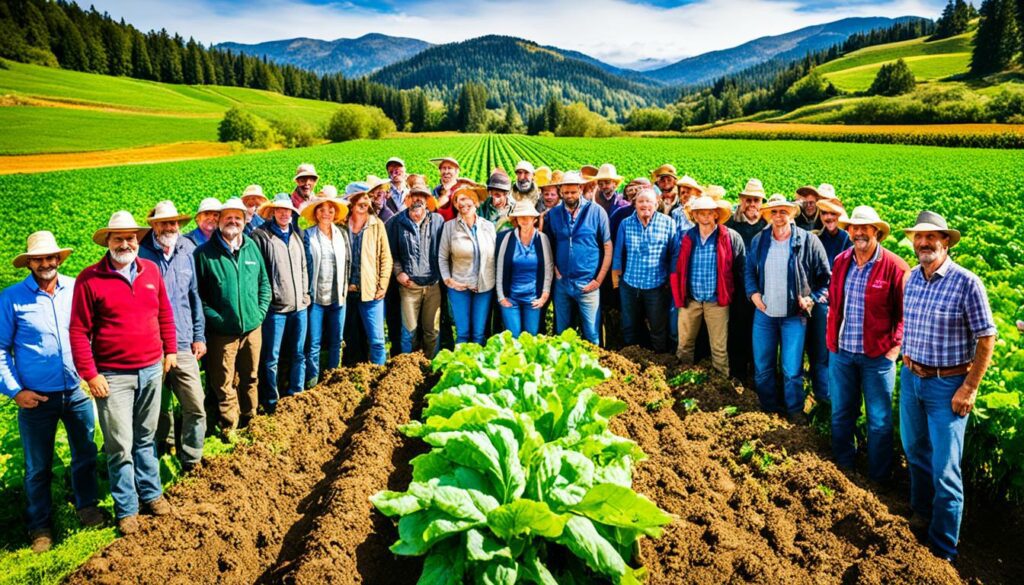
Joining public and private efforts boosts farming tech. It helps with big issues like climate change and making more crops. India aims to get big economic wins from farming tech by 2025. This shows how important these teamwork efforts are. Projects like E-Sahamathi and AI4AI in India are leading the way. They use the newest tech and share important data to help farming.
FAO’s guidelines for public-private partnerships in farming stress a systematic way of working. This helps reach goals for healthy food that lasts. The key is working together for new, green farming methods.
At the Global Forum on Farm Policy Innovation, the world showed it’s keen on tech in farming. Events at OECD’s place say using PPPs from all over the world can make farm policies and tech better. This helps farming trade globally and makes it more efficient.
| Country | Initiative | Impact |
|---|---|---|
| India | E-Sahamathi | Data sharing for agri-start-ups |
| Uganda | National Agricultural Investment Plan | Enhanced private sector engagement |
| Kenya | Post-2017 Workshop Initiatives | Strengthened agricultural partnerships |
Farmer cooperatives are a great way for farmers to work together in the agriculture world. By forming farmer cooperative networks, they can find more stability and grow their incomes.
Working together and sharing what they have is key for farmer cooperatives. For instance, look at the success of Blue Diamond Growers in California. They have over 3,000 members and have worked for more than a hundred years. They produce over half of California’s almonds, showing how well they work together. Their values of Partnership, Quality, Innovation, and Integrity are a big reason for their success.
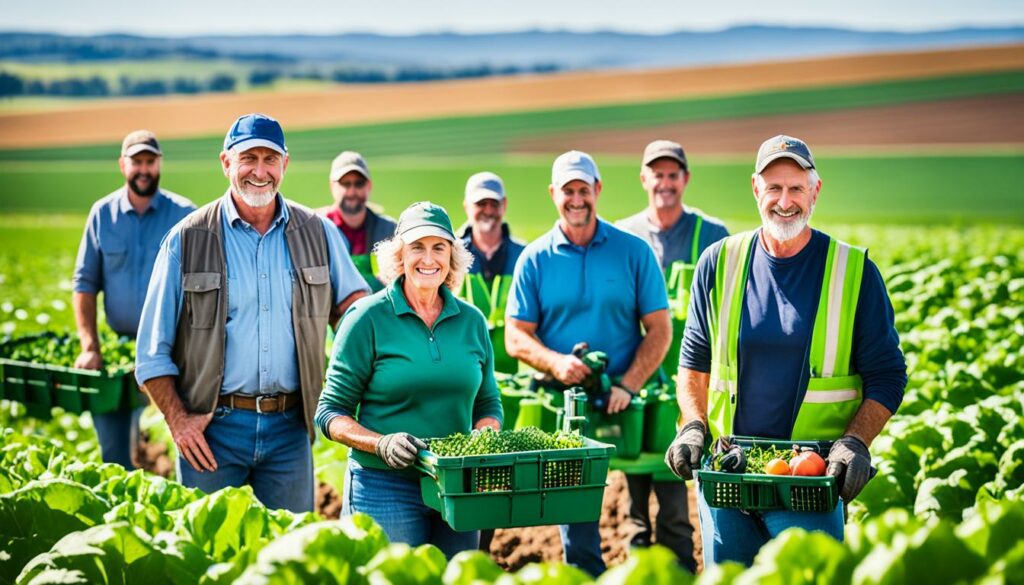
| Country | Rural Cooperatives | Farmland Managed by Cooperatives |
|---|---|---|
| United States | Mainly in Minnesota, Iowa, Wisconsin, California, and Illinois | N/A |
| Canada | Over 1,200 | N/A |
| Argentina | N/A | More than 80% |
Working together helps cooperatives do better in the market. Blue Diamond Growers is a great example. They sell a large variety of products like almond milk and NutThins crackers all over the world. Through collective market access, they can get better prices and steady demand.
There are over 1.2 million farming cooperatives worldwide. They help farmers earn more and make their areas better. These cooperatives bring benefits like better economy, high-quality goods and services, and support like legal help.
But, farmer cooperatives do face some problems, like keeping up with money, not enough workers, and not using digital tools enough. Even with these challenges, big cooperatives show what is possible through teamwork. They make the future of farming look brighter and more sustainable.
In the field of *sustainable agriculture*, working together on research is key. It drives forward methods that are strong and good for the environment. International experts and new ideas help make better ways to farm. These practices tackle the big issues like climate change. The AFRI Requests for Applications show how working with others from different countries can bring good things to American farming. This is critical because it lets the U.S. learn from and adopt global innovations.
When choosing who to work with internationally, it’s about making sure no one gets a special advantage. The goal is for everyone to help make farming sustainable. Those from outside the U.S. working on AFRI projects might also get money through U.S. partners. This way of funding is open and clear for all.
The AFRI has set up rules to support working globally. This includes making agreements with other countries by NIFA. This makes it easier for everyone to work together, sharing resources without the need to directly move money. This teamwork makes sure both local and global steps in a project flow smoothly.
Climate change challenges us with extreme weather and more pests. It makes us work together on global projects like the AFRI. Farms need special crops and soil care to stay strong. By making rules the same worldwide, going to new markets is simpler and trade becomes fairer. This helps economies grow all around.
“Collaborative project applications should be consulted with the AFRI Request for Applications point of contact to ensure alignment with sustainability objectives.”
AFRI gives out awards that can be for teams in the U.S. and beyond. This helps each team play to its strengths while aiming for the same sustainable goals. Across the world, these *research partnerships* are crucial. They push *sustainable agricultural growth*, guaranteeing food and economic safety in the long run.
| Application Aspect | Requirement |
|---|---|
| Eligible Institutions | U.S. only |
| Collaborative Benefits | Must benefit U.S. agriculture |
| Evaluation | Part of entire application |
| Funding | Through subcontracts |
| International Agreements | MoUs and other arrangements |
| Project Application | Consult AFRI point of contact |
| Climate Resilience | Adaptive crops and soil management |
By working together, we are making great progress in sustainable farming. These joint efforts offer strong solutions to the challenges of agriculture today.
Supply chain partnerships in agribusiness are crucial. They ensure food gets from the farm to your table efficiently. These partnerships help build trust and transparency. This makes food safer and cuts down on waste.
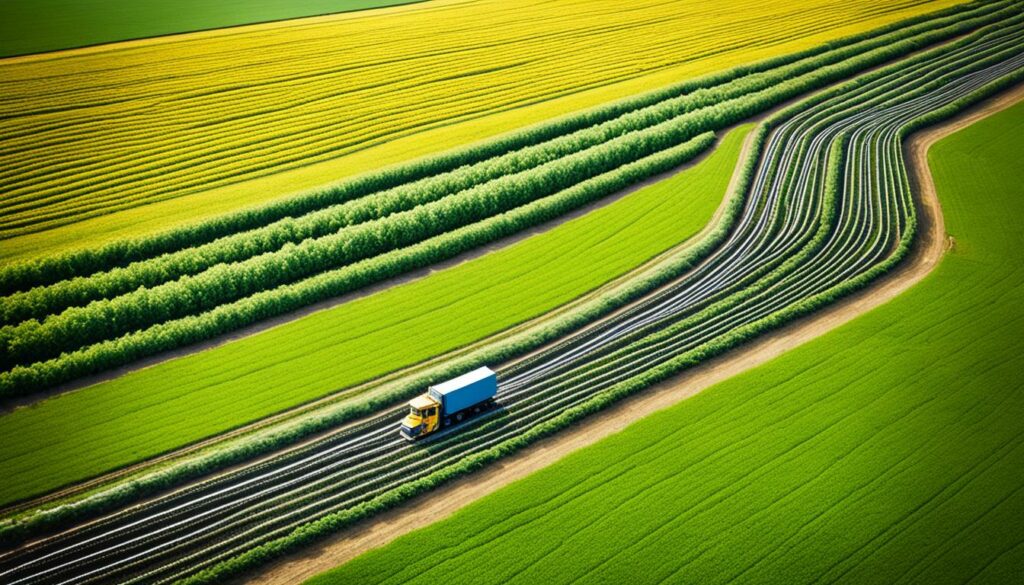
Effective supply chain partnerships are based on trust and open communication. Keeping the flow of agricultural products steady and reliable is key. Trust in this field is enhanced by things like blockchain. For example, IBM and Walmart are using blockchain to improve trust in their supply chains.
Transparency goes beyond just using technology. The world’s Global Food Safety Initiative is a big network. It shows how working together across the supply chain can make food safer. Major events, like the GFSI Conference, discuss how to integrate supply chains for better safety.
Good supply chain partnerships lead to better production and less waste. By working closely and being open across the chain, we can avoid many mistakes. Such an approach was recently backed by 134 countries at a big event in the UAE. This shows a strong global push towards more sustainable and less wasteful food systems.
At the UN Climate Change Conference, a big money pledge was made to tackle food and climate issues. This shows the world is serious about working together to make food production more efficient and waste less. Still, 32% of businesses find that not knowing enough about their supply chains is a big problem. Better technology and more teamwork, they say, could really help cut down on the waste we see today.
Participating in transnational farming initiatives is key for agriculture growth worldwide. The National Institute of Food and Agriculture (NIFA) highlights this. It allows for joint projects through its AFRI scheme, as long as U.S. groups lead them. This approach looks at the real value of global farming projects, making sure they help, not hurt, an application’s chances.
NIFA tells those interested to check for potential hurdles in the U.S. Bilateral Relations Fact Sheets. For applying, NIFA guides on how to divide costs clearly. Doing so makes managing these groups’ projects better. It also ensures everyone understands their part.
The AFRI scheme supports real-life, big-scale farming international agricultural endeavours. Projects with Ireland, Northern Ireland, CGIAR, and others show this. NIFA’s work with CGIAR is key to boosting food safety with new ideas.
NIFA partners with the U.S.-Israel fund called BARD, enhancing agriculture through joint research.
For instance, NIFA gave $3.4 million to a project on better wheat types. These projects help fight limits and boost farm results globally.
NIFA also likes when groups share efforts, even if they don’t swap funds directly. This has worked in solving big farm issues. Projects with U.S.-Ireland and U.S.-UKRI show its success.
Through NIFA, researchers get chances for transnational farming initiatives with various programmes. This helps address major global challenges like climate change and bug resistance. NIFA’s Centre for International Programs supports this move, making it easier for new partners.
| Partner Entity | Focus Area | Example Project |
|---|---|---|
| CGIAR | Food Security | Promoting scientific collaboration for a secure food future |
| BARD | Agricultural Research | Joint projects in agriculture and food research |
| UKRI | Soil Processes | Researching near-surface soil processes |
In today’s world, working with other countries on farming is crucial for our farms. The 2023 Global Forum on Farm Policy Innovation in Paris showed this well. It was organised by groups from different countries. They all agreed that sharing ideas and tech is key.
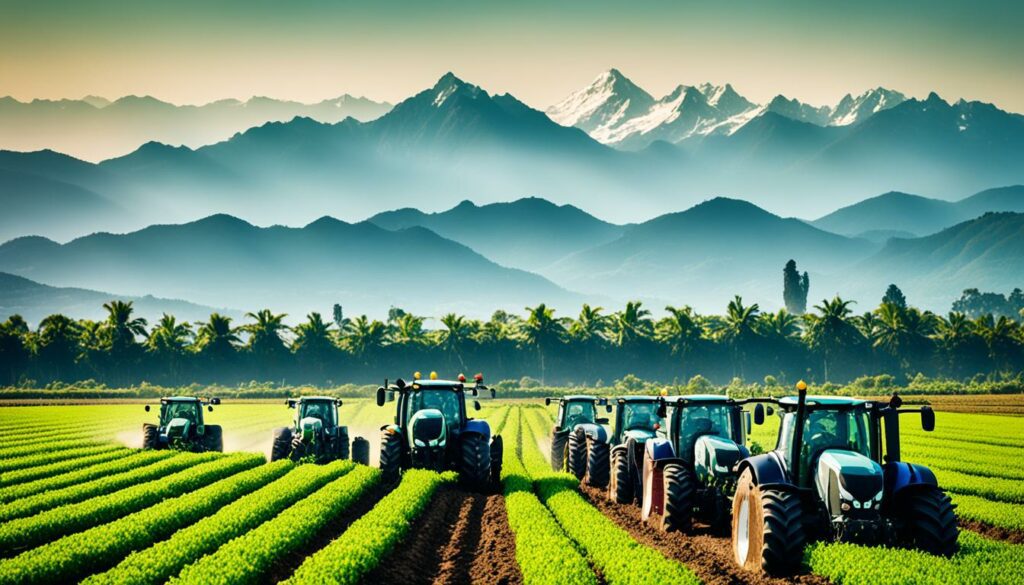
The GFFPI workshop focused on sharing agricultural tech to make farms better. Dr. Trey Malone, an expert, showed why sharing knowledge is important. Partnering with companies can bring new tech to farms, making them greener and more profitable.
Sharing what we know about farming was a big topic at the workshop. Farmers and experts talked about how to improve farming while caring for the planet. They all agreed that sharing information helps everyone.
The U.S. invested a lot, $2.8 billion, to help with 70 different farming projects. This showed a strong push for new farming ways through teamwork.
These methods help share useful farming technology and encourage learning together. This is key for our farms to be sustainable in the future.
| Key Focus | Investment/Initiative |
|---|---|
| Climate-Smart Practices | $3.1 billion for 70+ pilot projects |
| Fertiliser Efficiency | $20 million for Fertilize Right |
| Dairy Projects | $400 million for Partnerships for Climate-Smart Commodities |
| Green Climate Fund | $1 billion mobilisation |
It’s vital to get enough money for green farming projects. This helps the environment and the community. The money put in these projects leads to long-lasting good changes.
Helping farmers get access to agricultural finance is key. The U.S. Department of Agriculture (USDA) is putting more money into green farming. For example, they’ve offered $2.8 billion for projects that help fight climate change.
The National Institute of Food and Agriculture (NIFA) also plays a part. It helps farmers work with others around the world. This support makes sure efforts to make farming greener are truly global and local at the same time.
Making sustainability financial incentives match farming goals is crucial. Giving farmers money to use eco-friendly tech and methods is smart. In the U.S., the cotton industry got $90 million to be more sustainable.
Working with global partners, like the Tropical Agricultural Research Center, is important too. It means more money coming in for sustainable farming worldwide. This mix of local and international support tackles challenges in farming while aiming for a greener planet.
Climate-smart agriculture (CSA) is key for tackling both food security and climate change. The global agrifood system is responsible for a third of all greenhouse gases. It’s vital to adopt practices that focus on resilience. The World Bank is upping its financing for CSA projects to about $3 billion each year. This will make sure all new projects work towards the goals of the Paris Agreement.
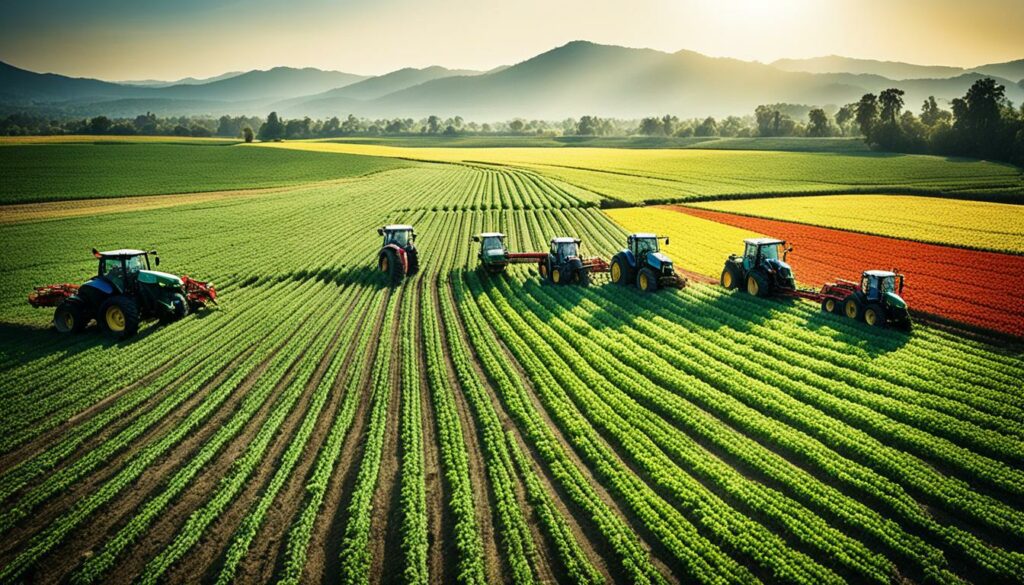
CSA’s goal is to make farming more resilient against climate changes. It does this by using practices that cut down emissions and boost productivity. With a global population set to reach 9.7 billion by 2050, we must increase food production. But, this must be done in a sustainable way. Agriculture’s impacts on deforestation make it urgent to change how we farm.
The World Bank supports major projects, such as China’s Green Agricultural initiative and Agriculture Resilience in Jordan. They also fund efforts in Eastern and Southern Africa to boost food systems resilience. The goal is to help 30,000 farming households in Jordan and create 12,000 jobs over five years. This shows the positive effect of CSA initiatives.
30 million people faced food insecurity in 2021 due to decreased crop yields from climate change.
This data highlights why CSA is crucial for keeping food production steady. With the agriculture sector accounting for 31% of global greenhouse gases, we need new solutions. Since 1961, there’s been a 20% drop in productivity. This indicates we must adopt farming practices that can adjust to new challenges.
The U.S. Agency for International Development (USAID) and the U.S. Development Finance Corporation are important players. USAID has invested $43 million in advancing CSA innovations. The Development Finance Corporation achieved its $1 billion goal for agriculture and food security in 2021. With over $3 billion invested, AIM4C supports over 51 Innovation Sprints to develop new CSA methods.
However, agrifood systems receive only 4% of climate finance. Only a fifth of this goes to smallholders, who really need the support. Better farm resilience not only protects farmers but also secures global food supplies.
Conservation agriculture is key to keeping our soil healthy and increasing biodiversity. It uses methods like minimum tillage and cover crops to help farming and nature work together. This improves the land’s productivity without hurting the environment.
In Morocco, the government and groups are greatly supporting conservation agriculture. They aim to have 1 million hectares using these methods by 2030. Through strong support and tailored advice, they are helping small farms benefit the most. The ultimate goal is to boost soil health and keep our plant and animal life thriving.
The government also helps by buying seed drills for farmers and providing technical aid. This allows small farmers to easily use these techniques. Their work benefits the local farming community and the environment in general.
Cover crops are vital in conservation farming. They cut down soil erosion and keep the earth rich in nutrients. Along with minimum tillage, they preserve soil quality and enhance soil health. The government in Morocco is glad to provide tools and knowledge for these methods.
So far, these efforts are proving to be a success. Activities like open farm days and subsidies help farmers learn and implement these practices. But, it’s also important to set rules to make sure everyone follows the same standards and that support goes where it’s truly needed.
In India’s Bihar, the use of zero tillage in wheat farming has shown great results. In Buxar, over 40% of wheat fields use this method, some even hitting 100%. There, wheat production has gone up, showing that these methods make farming more resilient and productive.
| Country | Conservation Agriculture Goals | Key Strategies |
|---|---|---|
| Morocco | 1 million ha by 2030 | Government support, advisory services, seed drills |
| Bihar, India | Increased yields | Zero tillage, cover cropping |
Sustainable farming needs strong policies and good advocacy. Global cooperation is essential due to climate change’s threats to agriculture. This includes unpredictable weather, lack of water, soil damage, and more pests and diseases. Convincing arguments for agriculture are crucial to make sure policies are backed by facts.
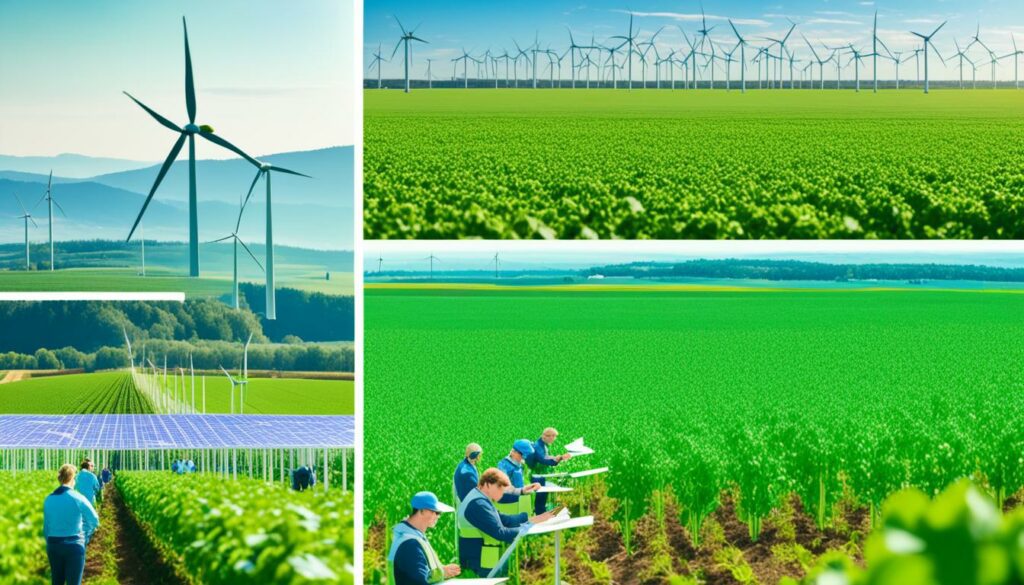
Creating strategies that link climate change and farming is key. Policies should be based on facts and deal with issues like the need for climate-ready seeds or managing soil well. Working together internationally makes rules similar, opens up more markets, and encourages fair trade. By sharing knowledge, experts can create farming practices that are strong and lasting.
Good advocacy includes talking with various people involved. The Global Forum on Farm Policy Innovation is where farmers, policymakers, and scholars meet. They talk about and make policies that help farming and the environment. These talks lead to better research, better farms, and savings with water and more precise farming methods. By talking and working together, we make policies that both work and last, helping nature and farming stay healthy.
| Challenges | Evidence-Based Solutions |
|---|---|
| Unpredictable weather patterns | Developing drought-resistant crops |
| Water scarcity | Water-efficient irrigation systems |
| Soil degradation | Sustainable soil management practices |
The world of farming is changing, thanks to digital agriculture innovations and agri-tech advancements. As we need more food and services from our environment, we must use these new ideas wisely. Digital technologies in agriculture like precision farming and artificial intelligence offer great help.
Advances in digital agriculture innovations are key to modern farming. Things like using GPS for precise directions and controlled farming paths matter a lot. Digital tools and remote sensors are also helping farmers get better data for more efficient work.
Projects like Digital for Resilience show how to use digital tools for farming. In Ghana, the ADVANCE II project helped farmers make more money and stay safe by using new technology. This proves agri-tech advancements are truly beneficial.
Digital agriculture innovations focus not just on making more but also on looking after the planet. Using smart machines and precision farming, we can farm in ways that keep our environment healthy. For example, the Naatal Mbay Project in Senegal improves its services for farmers using digital data.
Have you heard of the One Acre Fund? They help farmers reach their goals faster with digital tools. This is how digital agriculture innovations are making a difference.
Let’s explore the many ways these innovations are changing farming:
| Technology | Application | Impact |
|---|---|---|
| Precision Farming | Optimizing resource usage | Increased efficiency, reduced waste |
| IoT | Real-time monitoring | Enhanced decision-making |
| UAVs | Field surveillance | Improved crop management |
| AI | Data analysis | Predictive insights |
Policy support from the Kunming-Montreal Framework and the EU’s Farm to Fork plan is helping agri-tech advancements grow. They encourage innovation that is good for the earth and farmers.
By using these new digital tools, farming can become stronger and more sustainable. This creates a farming future that is good for everyone.
In places where farming is key, it’s vital to link farmers to markets. This is done through forming special partnerships that help get the farmers’ products to big markets. By doing this, farmers can sell more and gain more power in the markets. It helps them become more stable and grow economically.
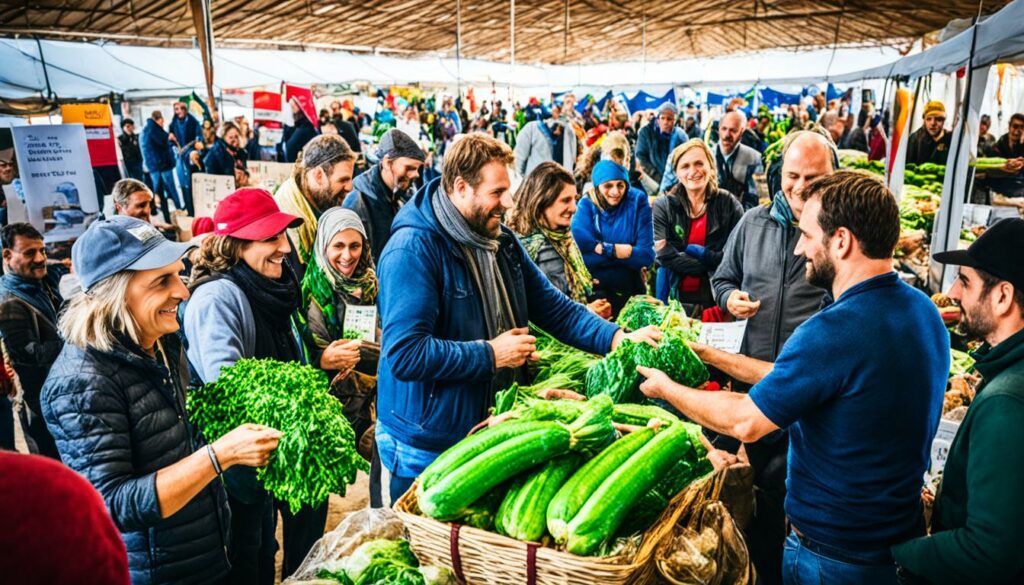
The Malawi-MLI project is a great example of making markets more available. It made 20 Grain Bulking Centers (GBCs) ready to buy from farmers. Using Modern Information Systems (MIS) helps to sell more of what farmers grow at better prices. This all links farmers closely with the whole market system, making prices fairer and boosting their food supply and money.
Helping farmers to sell more is good, but making them stronger in the market chain is better. The NCA-MLI project works on better handling and storing crops after they’re grown, lessening waste. It also improves the crop quality before it’s stored, making it ready for sale.
These actions help boost farming trade and give farmers more faith in their future. With the right support, they can control their economic path better.
Working together across intercontinental agricultural projects is key to moving towards sustainable goals. It helps the agri-food sector grow while caring for the environment. It’s about making sure our actions today benefit both people and the planet tomorrow. For example, the General Manager in Jerusalem said their project in Israel helps the local community a lot. This shows how these global projects can really change things for the better locally.
By joining hands across borders, we have a big positive impact on how we use our land and resources. Working with local farmers helps not just them, but also improves the way we do things in agriculture. This big effort shows that when we all work together, we can do great things for farming. The project in the Katif region is a perfect example. It proves that a united goal can bring about huge improvements in the way we farm.
Creating international trade bridges gaps between farming communities from far and wide. By doing this, we make it easier to trade fairly and freely. The partnership strengthens agreements that make businesses work better together. An initiative like the Inter-American Program boosts trade, agriculture, and food safety. Such projects really show the incredible effect knowledge and sharing resources can have. They help agriculture respond quickly to problems such as natural disasters and improve how we keep food safe.
In the end, coming together in intercontinental agricultural work is about more than just growing crops. It’s driving both farming and trading to be better, showing the real power of many united voices.
Cross-border cooperation is key for better agriculture. Public-private partnerships join different groups to make farms better. These partnerships make sure we use new ideas that work for everyone.
We have talked a lot about new ideas, how to sell products, and the help that comes from working together. Working together shares new knowledge and tech. This helps us fight world hunger and keep our planet safe.
Talking about how the US and EU work together on farm practices shows the power of these talks. We can make a worldwide way of farming better. This way, we make sure that agriculture keeps improving and we take care of the Earth for those who come next.
Working together across borders, through public-private partnerships (PPPs), boosts food security. These partnerships use sustainable farming that helps the economy, the environment, and society. They also encourage new ideas and help make better global food policies.
Farmers working together in different countries can reach more markets. This collaboration improves how farming is done, boosts the economy, and helps everyone get better food. They do this by linking farmers to markets, teaching new farming methods, and improving trade rules.
PPPs are key for bringing together the best skills and resources in farming. They fix land, technology, and knowledge gaps. This helps introduce new farming tech and puts big resources towards better farming. It all leads to stronger and more sustainable agriculture.
By working with different experts, like those in government and companies, farming groups boost tech use in agriculture. This team effort leads to new high-tech farming tools. These tools are vital for farming in a way that’s good for the earth and for people.
Farmer groups allow farmers to gather their resources. Together, they have more power to get better deals and markets. This way of working makes farming more effective and helps farmers make more money.
Farmer groups make it easier to sell what they grow. By selling together, they can get better prices and fair trade deals. This united approach helps farmers join the food market in a better way.
Research teams are key for making sure farming stays strong and good for the planet. They share new ways and tech that help the environment and the food we grow. This sharing drives farming forward, fighting problems like not having enough sustainable solutions.
Working together in the supply chain, everyone becomes more open and works better together. This makes the flow of food smoother and cuts down on waste. The end result: we get food to the table more efficiently.
With these partnerships, production gets better, and we waste less. They make the way food’s made and moved more straightforward. Good use of resources brings higher productivity and less food loss.
Global partnerships help farming projects worldwide with money, know-how, and advice. They make farming projects happen across countries. This helps make farming better for the environment and boosts international food trade.
Sharing top-notch farming tools in these partnerships is a big deal. It keeps things new and exciting, moving farming forward. The aim is to make farming more productive and earth-friendly for everyone in the farming community.
By getting everyone in the farming world to work together, new ideas are shared. Farmers, scientists, and leaders learn from each other, helping farming to grow and stay green. They spread the best methods and tech we have, all to keep farming better for the future.
Offering money in ways that care about the world and people goes well with modern farming goals. These funds help farmers use long-term, planet-friendly farming ideas. It’s a way of investing in the future of farming, helping it grow and get greener.
They’re key to making farming able to cope with climate changes, using methods that last. These green farming ways make sure we can keep growing food. They make farm systems stronger against the challenges our world faces.
Key ways these practices help are by covering the soil, not digging it up, and always having something on top of it. This keeps the soil in good shape, adds good stuff to it, and makes it a place where nature thrives.
Covering the ground and not digging too much keep the soil good and the plants happy. This leads to more and better food without hurting the soil. It’s a kind of farming that keeps on giving good results.
It’s crucial to make policies that really work and are based on good findings. This makes sure we do what’s best in farming, tackling real challenges and opportunities. It’s about making farming better for all, based on what we truly know.
Talking together helps make policies and ways of doing things that are fair and right for everyone. It gets more voices heard, leading to decisions that work well and include all views. This makes policies and actions in farming stronger for all.
New tech makes farming smarter, faster, and better. Tools like precise farming and drones mean we use resources well and know more about our crops. This makes growing food more efficient and informed.
Digital tools play a big part in changing how we farm for the better. With real-time info and good communication, farming becomes more effective. Tech helps manage resources, watch crops, and move things around easier, making farming less of a guess game.
Market links help farmers reach buyers without middlemen. This direct route makes sure farmers make fair deals and get good prices. It puts the power back in the hands of the people who grow our food.
By opening doors to better markets and prices, links make farmers stronger in the big picture. This way, farmers can do more and be more a part of the economy. It’s about giving farmers the chances they deserve.
Working together across the globe means we bring more to the table, like ideas, resources, and ways to solve problems. It’s a big push for farming to grow in a way that’s good for everyone and the planet. This shared effort helps us move forward together.
Trade links open up more markets and make working together across borders easier. This makes farming more connected and strong, boosting both trade and growth. It’s a way of farming that respects the whole world, leading to a better future for all.